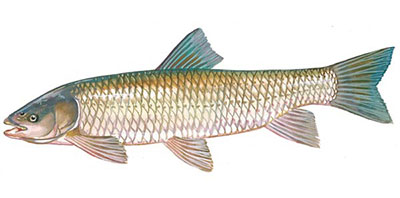Using Triploid Grass Carp for
Aquatic Plant Control in SC Small Impoundments
The triploid "grass carp" which is a sterile version of the white amur, has been used in South Carolina's private and public waters for the control of noxious aquatic plant species since 1984. Triploid grass carp are incapable of reproducing viable offspring.
Grass carp are selective feeders, preferring soft tissue aquatic plant species. Where more than one noxious plant species is present, the carp will feed almost exclusively on the more preferred plant species before targeting the other available aquatic plant species.
The following is a list of aquatic plant species commonly found in South Carolina's waters that grass carp will feed on:
 Preferred Plants
Preferred Plants
- Naja sp.
- Bladderwort sp.
- Coontail
- Hydrilla
- Salvinia
- Potomegton sp.
- Slender spikerush
- Elodea
- Duckweed
Nonpreferred Plants
- Water milfoil
- Cabomba
- Water lilies
- Cat-tails
- Water shield
- Water meal
- Pithophora algae
- Alligatorweed
- Water primrose
- Lyngbya algae
- Water hycanith
- Water lotus
- Pennywort
- Parrot's feather
Carp will consume those plants on the "non-preferred" list if other more desired plant species are not available. Control of those "nonpreferred" plant species may be incomplete or take longer for desired control levels.
Ponds which are seriously impacted by noxious aquatic plant species (high plant biomass), should be managed to reduce the plant biomass either through the application of selected aquatic herbicides or by other methods (drawdown, mechanical removal, ete.) Prior to stocking grass carp.
Stocking Rates
Recent research on grass carp stocking rates indicates to achieve control a stocking rate of 4-6 fish per ton of aquatic plant biomass must be used. Pond owners should consult with a SCDNR fisheries biologist or other qualified individuals to assess a stocking rate recommendation. Generally, in South Carolina a stocking rate between 10-40 fish per surface acre will be recommended, depending on the plant species and the biomass of plants present in the pond.
Size of Fish to Stock
In a new pond or a pond devoid of fish predators, a grass carp 6-12 inches in length can be used. In ponds having potential grass carp predators, a grass carp 12 inches or larger should be used.
Grass Carp Predators
The following is a list of potential grass carp predators that can seriously reduce or eliminate all grass carp:
- Man
- largemouth bass, bowfin, etc.
- osprey, herons, etc.
- otters
- alligators
The impact of predators on young grass carp is one of the major reasons aquatic weed control is not successful when using grass carp as a weed control method. Grass carp prefer shallow water for feeding and can easily be seen swimming in small groups or individually at the surface of the pond. If after stocking grass carp you fail to observe these fish feeding, swimming or at the surface of the pond, this could be an indication of poor or no grass carp survival.
Escapement
Grass carp can and will leave a pond via the emergency spillway or large concrete surface overflow systems during peak rain "events". Any overflow deeper than 3.0 inches will encourage the loss of grass carp.
Pond systems which utilize emergency spillways or large surface overflow systems, should use a barrier to prevent escapement. The most successful fish barrier designs incorporate horizontal steel bars, which have a 1.0 inch space between bars.
Care should be taken to keep the barrier clear of debris during high water periods. Failure to provide maintenance on the barrier at this time could result in complete failure of the barrier or could seriously damage the pond's dam.
Time to Stock
Grass carp should be stocked in the spring for best results. Early plant growth for South Carolina's aquatic plants begins in late March - April. Fish should be stocked at this time to allow them to aggressively feed on tender, young plant growth. Since the fish's metabolism is increasing with rising water temperatures, they grow at an accelerated rate and quickly reach a size that eliminates many potential grass carp predator problems.
Source of Fish
Triploid grass carp can only be sold in South Carolina by SCDNR approved grass carp vendors. A department permit is issued by the vendor to each individual who obtains these fish verifying the fish as being "triploids".
Length of Weed Control
Depending on the aquatic weed species, plant biomass, number of fish stocked, and grass carp survival, effective weed control success can vary from 1-10 years in most South Carolina ponds. Effective weed control should be evident 6-12 months after the initial stocking of the carp.
Grass carp and Bass / Bluegill
Grass carp are mainly herbivores but will consume insects, invertebrates, and other gamefish food organisms. There is no documentation that indicates that grass carp are serious predators on other fish species. Grass carp do compete with typical bass/bluegill populations for food, therefore, some competition between species does exist.
Grass carp will consume floating pelleted fish feeds and prefer these feeds over aquatic plants. In ponds where supplemental feedings of bream or channel catfish is desired, you may want to consider other aquatic weed control options.
If you have further questions or need additional assistance on the "use of grass carp", please call 803-734-3891.
A list of SCDNR approved triploid grass carp vendors can be obtained by writing to:
Hatchery Coordinator
SCDNR
Wildlife and Freshwater Fisheries
Post Office Box 167
Columbia, SC 29202
The information above regarding Using Triploid Grass Carp for Aquatic Plant Control in SC Small Impoundments is provided in a PDF format.
